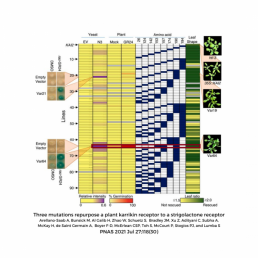Professor Shelley Lumba’s lab found out how benign plants develop the ability to become parasites on other plants in new research published in PNAS. Many plants release strigolactone hormones to promote beneficial interactions with soil fungi. Parasitic plants like witchweed can sense strigolactones extruded by host plants. By eavesdropping on this signal, they sense nearby host plants whose resources they can steal.
Witchweed uses HTL receptor proteins to sense strigolactone; evolutionary analysis indicates that HTL receptors in parasitic plants evolved from KAI2 receptors in non-parasitic plants. KAI2 receptors normally sense karrikin compounds released by burning plants, not strigolactone. Lumba and CSB graduate student Amir Arellano Saab examined differences in the active sites of HTL and KAI2 receptors responsible for their specificity to strigolactone and karrikin respectively. In the active site where HTL binds strigolactone, eight residues were different from KAI2, and were thus candidates for HTL’s specific response to strigolactone.
In collaboration with the McCourt lab at CSB and Dr. Peter Stogios in BioZone at the Faculty of Applied Science and Engineering, the Lumba lab searched for combinations of residues necessary for the switch from karrikin to strigolactone sensing. They knew that KAI2 relies on karrikin to interact with the MAX2 protein, so Lumba lab members determined whether changes in KAI2 residues can cause MAX2 interaction in the presence of strigolactone. After testing over 100 variant KAI2 proteins, the team was able to isolate five variants that depended on strigolactone for MAX2 interaction. One variant, Variant 64, had mutations in three out of the eight residues.
Each variant receptor was introduced into a strigolactone-insensitive plant to form independent transgenic plants by a team of undergrad project students. The Lumba lab tested each plant for the novel ability to germinate and grow in response to strigolactone. Two plants with a variant receptor responded to strigolactone; the strongest response was seen in Variant 64. Saab confirmed that Variant 64 can bind strigolactone directly and modeled the dynamics of ligand binding.
Lumba has shown that only three mutations are needed to turn KAI2 into a hybrid receptor that senses plant hormone strigolactone while retaining its native function to perceive karrikins. This reveals the initial changes that can result in the evolution of parasitism in plants. You can read more about this discovery in the PNAS paper “Three mutations repurpose a plant karrikin receptor to a strigolactone receptor“

